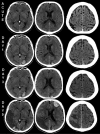Trousseau's Syndrome, a Previously Unrecognized Condition in Acute Ischemic Stroke Associated With Myocardial Injury
- PMID: 26425612
- PMCID: PMC4528894
- DOI: 10.1177/2324709614539283
Trousseau's Syndrome, a Previously Unrecognized Condition in Acute Ischemic Stroke Associated With Myocardial Injury
Abstract
Trousseau's syndrome is a well-known malignancy associated hypercoagulative state leading to venous or arterial thrombosis. The pathophysiology is however poorly understood, although multiple mechanisms are believed to be involved. We report a case of Trousseau's syndrome resulting in concomitant cerebral and myocardial microthrombosis, presenting with acute ischemic stroke and markedly elevated plasma troponin T levels suggesting myocardial injury. Without any previous medical history, the patient developed multiple cerebral infarctions and died within 11 days of admission. The patient was postmortem diagnosed with an advanced metastatic adenocarcinoma of the prostate with disseminated cerebral, pulmonary, and myocardial microthrombosis. Further analyses revealed, to the best of our knowledge for the first time in stroke patients, circulating microvesicles positive for the epithelial tumor marker CK18 and citrullinated histone H3 in thrombi, markers of the recently described cancer-associated procoagulant DNA-based neutrophil extracellular traps. We also found tissue factor, the main in vivo initiator of coagulation, both in thrombi and in metastases. Troponin elevation in acute ischemic stroke is common and has repeatedly been associated with an increased risk of mortality. The underlying pathophysiology is however not fully clarified, although a number of possible explanations have been proposed. We now suggest that unexplainable high levels of troponin in acute ischemic stroke deserve special attention in terms of possible occult malignancy.
Keywords: Trousseau; malignancy; myocardial infarction; stroke; thrombosis; troponin.
Conflict of interest statement
Figures



Similar articles
-
Multifocal cerebral infarction as the first manifestation of occult malignancy: Case series of trousseau's syndrome and literature review.Brain Circ. 2018 Apr-Jun;4(2):65-72. doi: 10.4103/bc.bc_1_18. Epub 2018 Jun 29. Brain Circ. 2018. PMID: 30276339 Free PMC article.
-
NETosis promotes cancer-associated arterial microthrombosis presenting as ischemic stroke with troponin elevation.Thromb Res. 2016 Mar;139:56-64. doi: 10.1016/j.thromres.2016.01.009. Epub 2016 Jan 12. Thromb Res. 2016. PMID: 26916297 Free PMC article.
-
The relationship between anemia and recurrence of ischemic stroke in patients with Trousseau's syndrome: A retrospective cross-sectional study.Turk J Emerg Med. 2016 May 9;16(2):65-68. doi: 10.1016/j.tjem.2015.11.013. eCollection 2016 Jun. Turk J Emerg Med. 2016. PMID: 27896324 Free PMC article.
-
Pathophysiology of Trousseau's syndrome.Hamostaseologie. 2015;35(1):52-9. doi: 10.5482/HAMO-14-08-0037. Epub 2014 Nov 18. Hamostaseologie. 2015. PMID: 25403091 Review.
-
Trousseau's syndrome: multiple definitions and multiple mechanisms.Blood. 2007 Sep 15;110(6):1723-9. doi: 10.1182/blood-2006-10-053736. Epub 2007 May 11. Blood. 2007. PMID: 17496204 Free PMC article. Review.
Cited by
-
Neutrophil extracellular traps promote cancer-associated inflammation and myocardial stress.Oncoimmunology. 2022 Mar 14;11(1):2049487. doi: 10.1080/2162402X.2022.2049487. eCollection 2022. Oncoimmunology. 2022. PMID: 35309730 Free PMC article.
-
Tissue factor expressed by circulating cancer cell-derived microparticles drastically increases the incidence of deep vein thrombosis in mice.J Thromb Haemost. 2015 Jul;13(7):1310-9. doi: 10.1111/jth.13002. Epub 2015 Jun 8. J Thromb Haemost. 2015. PMID: 25955268 Free PMC article.
-
Multifocal cerebral infarction as the first manifestation of occult malignancy: Case series of trousseau's syndrome and literature review.Brain Circ. 2018 Apr-Jun;4(2):65-72. doi: 10.4103/bc.bc_1_18. Epub 2018 Jun 29. Brain Circ. 2018. PMID: 30276339 Free PMC article.
-
Prognostic value of circulating markers of neutrophil activation, neutrophil extracellular traps, coagulation and fibrinolysis in patients with terminal cancer.Sci Rep. 2021 Mar 3;11(1):5074. doi: 10.1038/s41598-021-84476-3. Sci Rep. 2021. PMID: 33658563 Free PMC article.
-
NETosis promotes cancer-associated arterial microthrombosis presenting as ischemic stroke with troponin elevation.Thromb Res. 2016 Mar;139:56-64. doi: 10.1016/j.thromres.2016.01.009. Epub 2016 Jan 12. Thromb Res. 2016. PMID: 26916297 Free PMC article.
References
-
- Trousseau A. Phlegmasia alba dolens. Lectures on Clinical Medicine, Delivered at the Hotel-Dieu, Paris. Vol. 5 London, England: New Sydenham Society; 1865:281-332.
-
- Davila M, Amirkhosravi A, Coll E, et al. Tissue factor-bearing microparticles derived from tumor cells: impact on coagulation activation. J Thromb Haemost. 2008;6:1517-1524. - PubMed
LinkOut - more resources
Full Text Sources
Other Literature Sources

